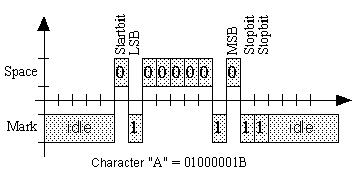Background information:
Asynchronous Data Transmission
Basics
In serial, asynchronous data transfer the individual bits which comprise each data byte are sent one after the other over a single line. In this context, asynchronous means that the clock information is not included with the transmission, so that frequent re-synchronization using start/stop bits is required. A data format of 8 data bits, no parity and 1 stop bit thus requires for example a time synchronization overhead of 20%. In synchronous data transmission this relationship is more favorable, since here the clock information is sent either on its own line or together with the data.
The quiescent state of the transmission line, which is also designated as "Mark", corresponds to the level of a logical "1". The voltage or current levels used for transmission can be found in the description of the individual interfaces.
Transmission of a byte starts with a preceding start bit, which is sent as a logical "0". Next 5 to 8 data bits are sent in sequence, starting with the LSB. A parity bit may follow the last data bit and used for detecting transmission errors. The parity bit causes an even number of "1" bits to be sent for even parity, and an uneven number of "1" bits for odd parity. The end of the character can optionally be comprised of at least 1 or 2 stop bits. All bits are sent sequentially at speeds of between 50 and 115200 baud.

Data Flow Control:
To prevent data losses, the receiver must be able to stop data transmission if no more data are able to be processed. This so-called handshake can be implemented in one of two ways:
- Software handshake:
The receiver sends special characters to the sender to control the data flow. One widely used method is the XON/XOFF handshake, whereby ASCII characters 11H and 13H are used.
- Hardware handshake:
The receiver controls the data flow using the level of special handshake lines
Definition of the signals in modem operation
TxD/RxD (Transmit Data/Receive Data) are used for data exchange between the DTE terminal device and the modem.
RTS/CTS (Request to Send/Clear to Send) are the signals used for hardware flow control. By setting the RTS line to "ON" the computer tells the modem that it is ready to receive data. The function of these lines can be changed or turned off using the computer’s software or by means of the corresponding modem control commands.
DTR (Data Terminal Ready) uses an "ON" to tell the modem that the connected data device is turned on and is ready. In addition, the modem can be configured such that it disconnects itself from the telephone line when there is an "ON/OFF" edge change and deactivates the auto answer mode. Corresponding control commands can be used to turn off processing of the DTR line on the modem.
DSR (Data Set Ready) tells the connected computer that the modem is ready. The corresponding modem command can be used to turn off the function of this line, and the level of this line is then held to a constant ON.
DCD (Data Carrier Detect) goes into the "ON" state when a data carrier signal has been detected on the "mail side". The function of this signal as well can be disabled using a modem command. In such cases the level will be constantly "ON".
RI (Ring Indicator) is set to "ON" for the duration of the ring character when there is an incoming call.
Definition of the signals in other data technology
From the description of the signals required for modem operation it can be seen that some control functions are only relevant when operating in the public switched network. In addition, the functions of the basic ready state (DTR/DSR) and of flow control (RTS/CTS) can be combined when direct-connecting two DTEs, so that in this case only 4 signals (plus the ground line) are needed for data transmission with hardware handshaking.
TxD/RxD (Transmit Data/Receive Data) are used for data exchange between the DTE terminal device and the modem.
RTS/CTS or DTR/DSR The terminal device indicates its readiness to receive data by setting the handshake output to "ON". Accordingly, "Not ready" is signaled by "OFF. On the other hand, the terminal device will only send data to the partner if its own handshake input has an ON level. Depending on the model and manufacturer, the combinations of handshake in- and outputs may differ. For example, industrial controllers generally use the RTS/CTS signals, whereas most printers send their ready message using DTR. When in doubt, consult the documentation from your manufacturer.